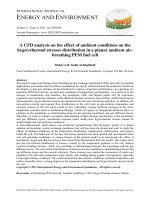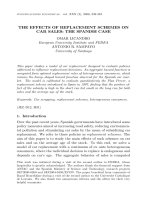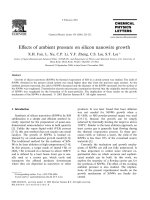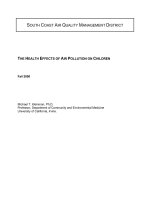- Trang chủ >>
- Khoa Học Tự Nhiên >>
- Vật lý
Effects of ambient pressure on silicon nanowire growth
Bạn đang xem bản rút gọn của tài liệu. Xem và tải ngay bản đầy đủ của tài liệu tại đây (582.45 KB, 4 trang )
Eects of ambient pressure on silicon nanowire growth
X.H. Fan, L. Xu, C.P. Li, Y.F. Zheng, C.S. Lee, S.T. Lee
*
Center of Super-Diamond and Advanced Films (COSDAF), and Department of Physics and Materials Science, City University of
Hong Kong, Hong Kong, People's Republic of China
Received 25 September 2000; in ®nal form 9 November 2000
Abstract
Growth of silicon nanowires (SiNWs) by thermal evaporation of SiO in a closed system was studied. The yield of
SiNWs obtained in the present closed system was much higher than that from the previous open systems. As the
ambient pressure increased, the yield of SiNWs decreased and the diameter of the SiNWs increased, but the surface of
the SiNWs was roughened. Transmission electron microscopic examination showed that the originally smooth surface
of SiNWs was roughened by the formation of Si nano-particles. The implication of these results on the growth
mechanism of the SiNWs is discussed. Ó 2001 Elsevier Science B.V. All rights reserved.
1. Introduction
Synthesis of silicon nanowires (SiNWs) by SiO
sublimation is a simple and ecient method re-
cently reported for the preparation of quasi-one-
dimensional semiconductor wires in bulk quantity
[1]. Unlike the vapor±liquid±solid (VLS) process
[2±5], this new method does not require any metal
catalyst. The growth of SiNWs is instead ex-
plained by an oxide-assisted growth model [6±8].
The traditional method for the synthesis of SiN-
Ws is by laser ablation at high temperatures [3±6].
In this process, a target made of (metal + Si) or
(SiO
2
+ Si) is heated in a furnace to about 1200°C
and is ablated by a laser beam. Inert gas is usu-
ally used as a carrier gas, which cools and
transports the ablated products downstream
where they are deposited as nanowires or other
products. It was later found that laser ablation
was not needed for SiNWs growth when a
Si + SiO
2
or SiO powder-pressed target was used
[1,9±11]. Instead, the growth can be simply
achieved by thermally heating the target to above
1100°C. Similar to the laser ablation approach, an
inert carrier gas is generally kept ¯owing during
the thermal evaporation process. In these pro-
cesses (with or without a laser), the yield of the
SiNWs is less than 10% of the consumed source
materials [1].
Currently the nucleation and growth mecha-
nisms of SiNWs are still not fully understood. It
is thus important to collect more relevant ex-
perimental data on which accurate and sophisti-
cated models can be built. In this work, we
explore the necessity of a ¯owing carrier gas for
the synthesis of SiNWs. The eect of the working
ambient pressure is also studied. The implica-
tions of the present experimental results on the
growth mechanism of SiNWs are ®nally dis-
cussed.
9 February 2001
Chemical Physics Letters 334 (2001) 229±232
www.elsevier.nl/locate/cplett
*
Corresponding author. Fax: +852-2784-4696.
E-mail address: (S.T. Lee).
0009-2614/01/$ - see front matter Ó 2001 Elsevier Science B.V. All rights reserved.
PII: S 0 0 0 9 - 2 6 1 4 ( 0 0 ) 0 1 366-X
2. Experimental
The apparatus used here was the same as that
reported before [3±8]. An Al
2
O
3
tube (about 38
mm in diameter and 760 mm in length) was placed
inside a horizontal tube furnace. A few grams of
SiO powder (purity: 99.98%, particle size: $45 lm,
density: 2.1 g/cm
3
) was put into a 72 mm long
Al
2
O
3
boat at the center of the furnace. The Al
2
O
3
tube was pre-evacuated to 10
À2
Torr, and then
®lled with ambient gas (Ar + 5% H
2
) to a dierent
pressure. Then the system was closed by cutting o
the inert gas and sealing the vacuum system. The
temperature of the furnace was then brought to
1350°C and maintained for 2 h. As a result, loose
material with a color of light-brown to yellow
deposited at both ends of the tube, about 185 mm
from the center of the furnace. The temperature of
the deposition locations was measured to be about
950°C. In the experiment, it was found that the
loose material grew very quickly, and in about 2 h,
it ®lled up the whole cross-section of the tube.
Further examinations with transmission electron
microscopy (TEM) con®rmed that the loose ma-
terial was SiNWs.
3. Results and discussion
It was found that the ambient pressure had an
important eect on the yield and morphology of
the SiNWs. The yield of SiNWs obtained in the
present closed system was twice that obtained in
the previous open system with a ¯owing inert gas,
reaching a value of about 20% (wt) of the con-
sumed SiO source materials. As the pressure in-
creased, the yield of SiNWs decreased.
The reason for a lower yield of SiNWs at high
pressure can be attributed to two factors. First,
less SiO vapor was evaporated at the position of
the SiO source due to the presence of inert gas [12].
In this case, the surface of the source materials was
surrounded by a thin vapor layer through which
the atoms or molecules evaporating from the
source materials would diuse. Once the atoms or
molecules reached the outer boundary of the layer,
they could be carried away or returned to and re-
deposited on the source materials due to collisions
with the inert gas, thus leading to a reduced
evaporation rate as compared with that in a vac-
uum. It can be derived that the rate of material loss
from the source varies inversely with the inert gas
pressure. Next, diusion was responsible for
transporting SiO vapor from the source to the
depositing position. The diusion coecient also
has an inverse relationship with the ambient
pressure P [12]. The above two factors both give
rise to a slower rate of supply of SiO vapor for
deposition at a higher ambient pressure. This in
turn leads to a lower deposition rate of SiNWs.
For an open deposition system with ¯owing inert
gas, the eect of ambient pressure on the evapo-
ration rate of SiO source is less signi®cant, because
the evaporated atoms or molecules are swept away
by the carrier gas from the surface of the source
material. As the ¯owing gas keeps on transporting
SiO vapor to the deposition location, the ambient
pressure would thus have a lesser eect on the
partial pressure of the SiO vapor at both the
evaporation and the deposition locations. Fur-
thermore, in an open system, some smaller SiNWs
are likely to be swept away from the system by the
carrier gas. These factors collectively lead to lower
yields of SiNWs in an open system than in our
closed system.
The morphologies of SiNWs deposited in the
present closed system at dierent pressures were
characterized by TEM. As shown in Fig. 1a, under
an ambient pressure of 100 Torr, all SiNWs have a
smooth surface and an average diameter of 18 nm.
As the ambient pressure was increased to 200 Torr,
the wires were of similar diameter to those de-
posited at 100 Torr. However, a certain amount of
nano-particles appeared on the surface of some
nanowires (Fig. 1b). When the ambient pressure
was increased to 300 Torr, the surface of all
nanowires was packed with numerous nano-par-
ticles (Fig. 1c), and the wire diameters were
coarsened to about 45 nm. Fig. 2 shows a typical
Si nano-particle whose crystal lattice is separated
from that of the bulk SiNW by an amorphous
layer. This suggests that the particle was formed
on the surface of the SiNW after the nanowire had
formed. This kind of particle has not been ob-
served on SiNWs synthesized with the open sys-
tem.
230 X.H. Fan et al. / Chemical Physics Letters 334 (2001) 229±232
From the thermodynamics of nucleation, the
critical nucleus size is: r
Ã
À2caDF
v
; where c is
the speci®c interfacial free energy of the conden-
sate±vapor interface and DF
v
is the bulk free en-
ergy change per unit volume. DF
v
can be expressed
as: DF
v
RT lnP
p
aP
e
aV
m
, where P
p
is the virtual
partial pressure of the vapor and P
e
is the equi-
librium vapor pressure at the site of deposition, T
is the deposition temperature, R is the gas con-
stant, and V
m
is the molar volume of the nuclei
[13]. As analyzed above, P
p
would be lowered at a
higher ambient pressure P because of the lower
evaporation rate of SiO at the source and the
lower diusion coecient in the transportation of
vapor from source to deposition site. The param-
eters P
e
and V
m
are decided only by the tempera-
ture. In our experiments, SiNWs grow at the same
temperature under dierent ambient pressures.
Therefore, as P increased, P
p
aP
e
would decrease,
and thus DF
v
would decrease and r
Ã
becomes
larger. This can then explain why the diameter of
SiNWs is larger at a higher ambient pressure. The
large r
Ã
means that nucleation is more dicult, or
it is more dicult for clusters formed in the vapor
to become independent nuclei which can grow to
form SiNWs, because of insucient supply of va-
por at a higher ambient pressure. On the other
hand, the lower SiO vapor pressure at the depo-
sition site also causes a lower growth rate of
Fig. 2. HRTEM image of a nano-particle attached on the
surface of a nanowire.
Fig. 1. Morphologies of SiNWs synthesized in a closed system.
Inset diraction patterns show the nanowires are SiNWs. The
SiO sublimating temperature is 1350°C and the ambient gas
pressure is: (a) 100 Torr; (b) 200 Torr; (c) 300 Torr.
X.H. Fan et al. / Chemical Physics Letters 334 (2001) 229±232 231
SiNWs for the same reason. As a result, only some
of the clusters can become independent nuclei and
grow one-dimensionally into SiNWs. Other clus-
ters just nucleate and assemble as nano-particles
attached on to the surface of the SiNWs, because
heterogeneous nucleation on the surface of SiNWs
is easier than forming a new independent nucleus.
In the case of SiNWs depositing in an open system,
there is a continual supply of SiO vapor, and the
ambient pressure has less of an eect on the rate of
evaporation and nucleation. Thus, the critical size
of nuclei is primarily determined by the local tem-
perature at the nucleation site. Nevertheless, the
morphology of condensates in dierent tempera-
ture regions is dierent with dierent formation
mechanisms (these will be discussed elsewhere [14]).
4. Conclusions
In summary, the yield and growth rate of SiN-
Ws by thermal evaporation of SiO powder are
higher in a closed deposition system without cir-
culation of inert carrier gas, but decrease with in-
creasing ambient pressure. These are attributed to
the change of the evaporating rate of SiO powders
with the change of the ambient gas pressure. A
lower pressure not only enhances the yield of
SiNWs, but also ensures the SiNWs have a smooth
surface. At a higher pressure, more Si nano-par-
ticles are formed and attached on to the surface of
the SiNWs. This can be explained by considering
the thermodynamics of nucleation and the supply
rate of SiO vapor.
Acknowledgements
This work was supported by the Research
Grants Council of Hong Kong (Project number
9040459). The authors are grateful to Professor
L.S. Hung for useful discussions.
References
[1] Y.F. Zhang, Y.H. Tang, C. Lam, N. Wang, C.S. Lee, I.
Bello, S.T. Lee, J. Cryst. Growth 212 (2000) 115.
[2] J. Westwater, D.P. Gosain, S. Tomiya, S. Usui, J. Vac. Sci.
Technol. B 15 (1997) 554.
[3] A.M. Morles, C.M. Lieber, Science 279 (1998) 208.
[4] Y.F. Zhang, Y.H. Tang, N. Wang, C.S. Lee, I. Bello, S.T.
Lee, Appl. Phys. Lett. 72 (1998) 1835.
[5] N. Wang, Y.H. Tang, Y.F. Zhang, C.S. Lee, I. Bello, S.T.
Lee, Chem. Phys. Lett. 283 (1998) 368.
[6] N. Wang, Y.F. Zhang, Y.H. Tang, C.S. Lee, S.T. Lee,
Appl. Phys. Lett. 73 (1998) 3902.
[7] N. Wang, Y.H. Tang, Y.F. Zhang, C.S. Lee, S.T. Lee,
Phys. Rev. B 58 (1998) R16024.
[8] S.T. Lee, N. Wang, Y.F. Zhang, Y.H. Tang, MRS Bull. 24
(1999) 36.
[9] D.P. Yu, Z.G. Bai, Y. Ding, Q.L. Hang, H.Z. Zhang, J.J.
Wang, Y.H. Zou, W. Qian, G.C. Xiong, H.T. Zhou, S.Q.
Feng, Appl. Phys. Lett. 72 (1998) 3458.
[10] N. Wang, Y.H. Tang, Y.F. Zhang, C.S. Lee, I. Bello, S.T.
Lee, Chem. Phys. Lett. 299 (1999) 237.
[11] J.L. Gole, J.D. Stout, W.L. Rauch, Z.L. Wang, Appl.
Phys. Lett. 76 (2000) 2348.
[12] J.M. Laerty, Foundations of Vacuum Science and Tech-
nology, Wiley, New York, 1997.
[13] C.F. Powell, J.H. Oxley, J.M. Blocher, Vapor Deposition,
The Electrochemical Society, Wiley, New York, 1966, pp.
126±130.
[14] H.Y. Peng, Z.W. Pan, L. Xu, X.H. Fan, N. Wang, C.S.
Lee, S.T. Lee, Advanced materials, in press.
232 X.H. Fan et al. / Chemical Physics Letters 334 (2001) 229±232









